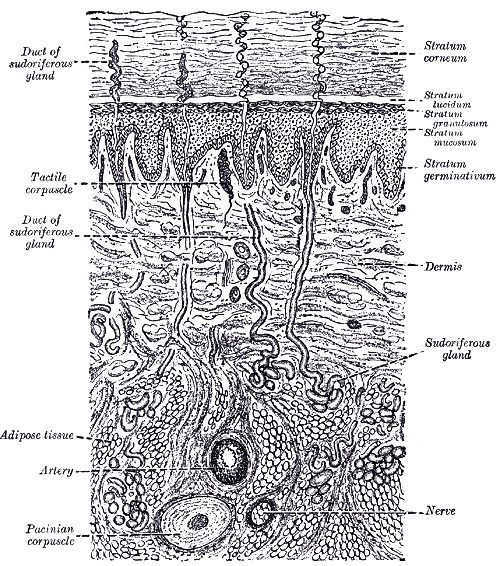Very simple: Why (and how) is regenerated skin different from original ?
As we know we lose skin cells that becomes the dust in out homes and it always grows back to full thickness right ? So when I have a cut, I imagined it to heal provisionally with whatever possible and then after some time to replace itself with the normal skin that is coded in my chromosomes. So why doesn't it do that ? Scars remain and the color is always different from the neighbor parts.
Update:
- Why we get scars?
- What about skin transplants ?
- Why doesn't skin actually grow/replace itself?
Update 2:
- (I've been thinking) Skin has lots of different layers, right ? So when an area is damaged does it regenerate all layers or just one for being simple and efficient (in "hope" the subject will take precautions not to damage this part of body again, so that regenerating everything back to 100% would be overkill) ?
- I'm not a scientist, I have only the basics from school, so I'll probably not understand most of the technical terms
- also I'm more interested about an explanation that goes towards the "survival of the fittest" rule, and not so much about the biochemical reactions in our bodies (because it was just some random mutation that turned out to be the better choice for us → why?)
Answer
Human skin is made up of three layers [1]:
- Epidermis; it contains no blood vessels; it has 5 cellular layers (starting from surface):
- stratum corneum
- stratum lucidum
- stratum granulosum
- stratum spinosum
- stratum germinativum
- Dermis; it is separated from the above by the basal membrane; made up of connective tissue (with blood vessels and nerve endings)
- Hypodermis - it is not even considered part of the skin

"Gray940". Licensed under Public domain via Wikimedia Commons.
Why (and how) is regenerated skin different from original ?
Why? Skin is a very important organ. It protects from pathogens, it maintains body temperature, it keeps body water [1], etc. How? That depends on what causes the regeneration. I've emphasized two terms in the above list.
- Stratum corneum represents the "skin cells that becomes the dust in our homes and it always grows back to full thickness". It is lost during a physiological process called desquamation [2]. The cells that are lost are non living corneocytes. Their only purpose is to from a protection barrier [3].
- Basement membrane holds the germinativum layer of the epidermis. Injuries that do not affect it are repaired by complete regeneration of all destroyed layers. However, if the injury destroys membrane continuity, the germinative cells on the edges will fail to "reconnect" with each other, thus the layers derived from them will follow the same rule. A process of fibrosis is triggered. The result of extensive fibrosis is a scar, containing collagen secreted by the granulation tissue with dermal origins. Yet, the germinative layer tends to join back together [6], but probably the excess collagen production, without the limiting basement membrane, bulges into the epidermis and limits germinative layer extension. That's why keeping the edges of the tissue close to each other reduces excessive fibrosis and allows germinative layer regeneration, thus resulting in none to small, barely visible scars.
How deep should an injury be in order not to affect basement membrane? No more than 0.06 to 0.08 mm [5].
What about skin transplants ?
Skin grafts contain at least a part of dermis [4], which will allow granulation tissue formation thus permitting revascularisation and making the graft stick. Otherwise it would fall off and/or be lost by necrosis.
References:
- Wikipedia contributors, "Skin," Wikipedia, The Free Encyclopedia, http://en.wikipedia.org/w/index.php?title=Skin&oldid=619454074 (accessed August 4, 2014).
- Wikipedia contributors, "Desquamation," Wikipedia, The Free Encyclopedia, http://en.wikipedia.org/w/index.php?title=Desquamation&oldid=614028888 (accessed August 4, 2014).
- Wikipedia contributors, "Stratum corneum," Wikipedia, The Free Encyclopedia, http://en.wikipedia.org/w/index.php?title=Stratum_corneum&oldid=615247326 (accessed August 4, 2014).
- Wikipedia contributors, "Skin grafting," Wikipedia, The Free Encyclopedia, http://en.wikipedia.org/w/index.php?title=Skin_grafting&oldid=603324006 (accessed August 4, 2014).
- Sandby-Møller J, Poulsen T, Wulf HC. Epidermal thickness at different body sites: relationship to age, gender, pigmentation, blood content, skin type and smoking habits. Acta Derm. Venereol. 2003;83(6):410-3. doi: 10.1080/00015550310015419. PubMed PMID: 14690333.
- Dawn A. Tamarkin, Ph.D. Repair of skin. 2011 STCC Foundation Press. Available from http://faculty.stcc.edu/AandP/AP/AP1pages/Units1to4/skin/repairof.htm (accessed 04.08.2014)
No comments:
Post a Comment